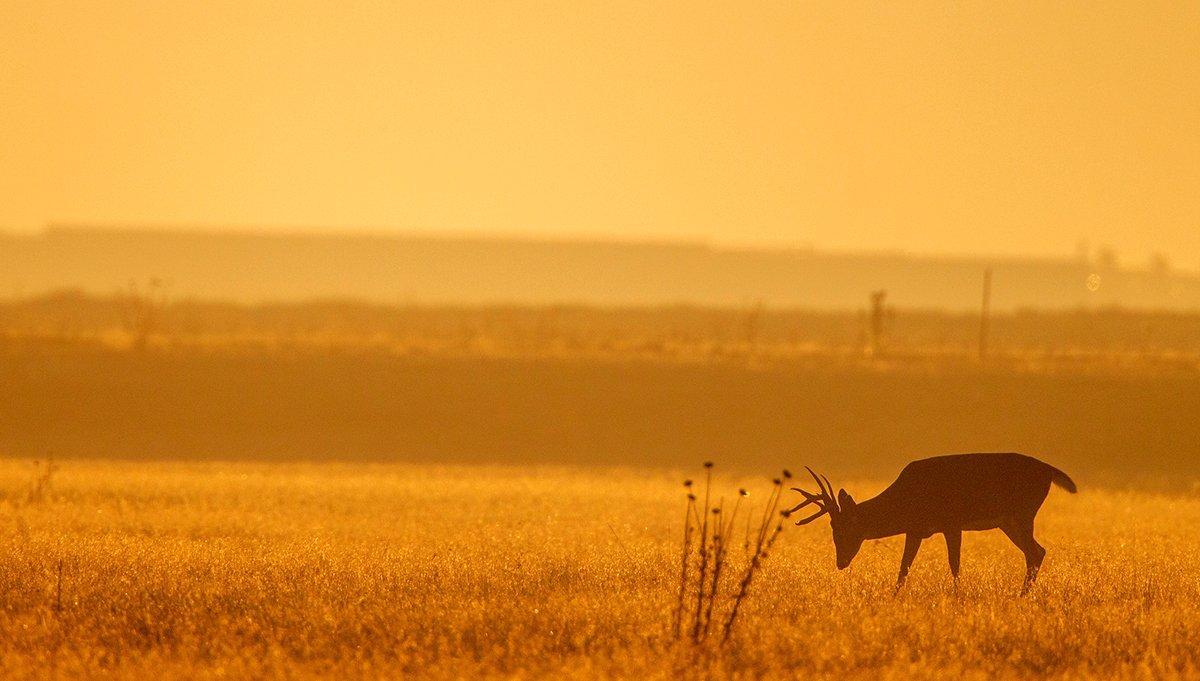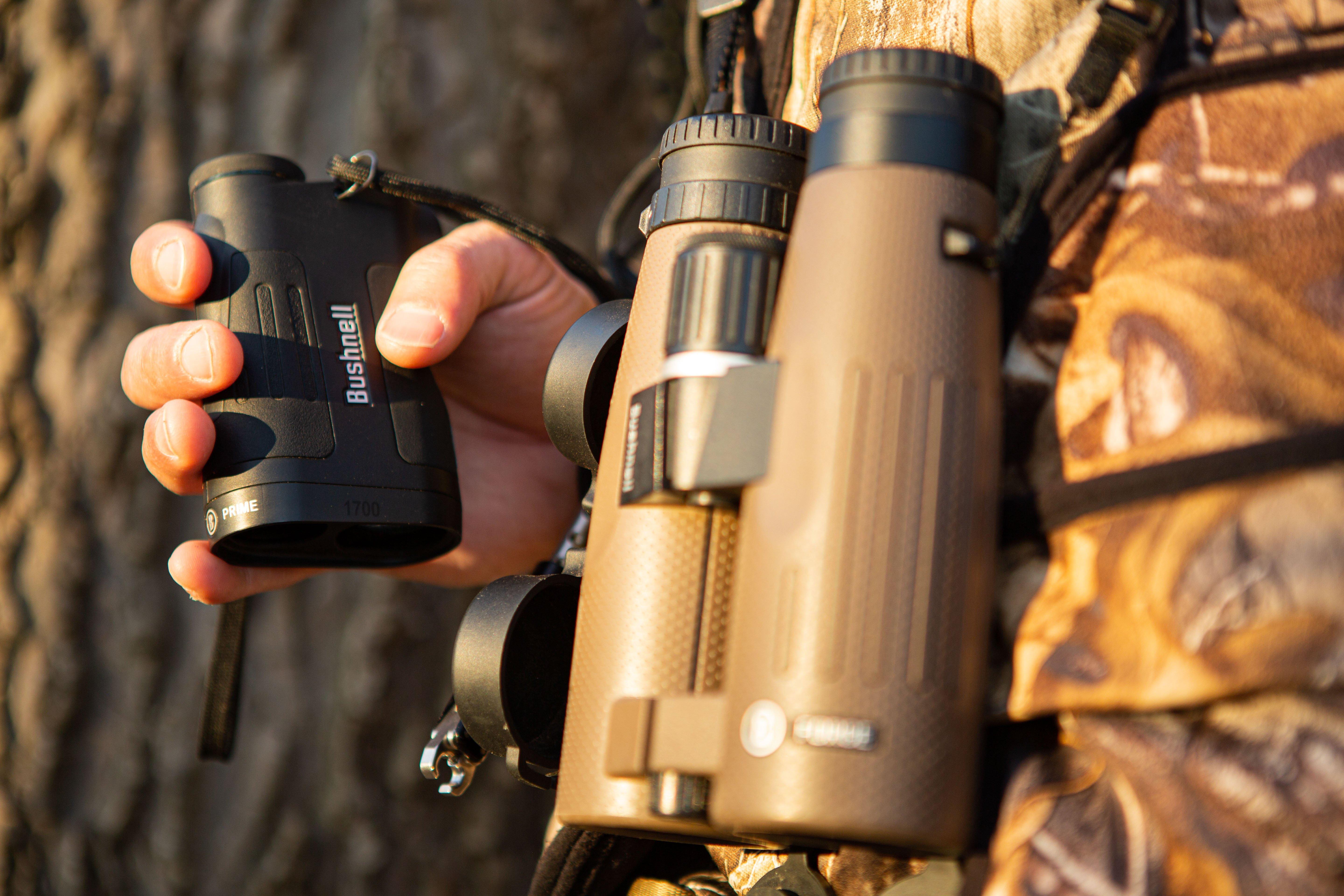Is it 40 yards? 50? 60? Is it up to the individual, or is there a yardage line in the sand?
After hearing a snort-wheeze, I trained my eyes on the shelterbelt south of my stand. First I spotted a young buck, but then I saw bits and pieces of larger antlers in the background. The dandy public-land 10-pointer was a no-brainer; I readied my bow for what appeared to be a fast-unfolding 30-yard opportunity.
The buck changed his course, however. He missed the 30-yard lane, so I scanned for a subsequent opening. The young buck walked through a wide-open lane, and my rangefinder zapped him at 43 yards. The larger buck was following, so I attached my release, drew when he entered the opening, then mouth-grunted to stop him. I honestly couldn't have walked up and placed the arrow more perfectly through his vitals. He crashed just inside the shelterbelt.
Obviously, shot distance is a highly debated bowhunting topic. I know many bowhunters who wouldn't dream of taking a 43-yard shot at a buck, but I also know others who'd shoot much farther. That lands us on an important question: How far is too far to shoot a buck?
Getting Started
To begin, let me note that the question doesn't have a one-size-fits-all answer, and that's because of the many variables in each and every encounter. We cannot ignore the factors that must be considered before releasing an arrow. I'm going to address some of those things first, but don't worry: I'll draw some conclusions at the end of the article rather than leave the question open-ended. But, first thing's first.
(Don't Miss: The Sleepover Buck)
Skill Level and Composure
Skill level is one of the largest deciding factors in ethical shot distance. Have you been shooting a bow for 2 months or 20 years? Do you execute your shots properly with a surprise release, or do you suffer from target panic? Do you practice realistic hunting shots, or do you merely plink your backyard buck target from 20 yards? Can you hit a baseball every time at 60 yards, or do you struggle to hit a paper plate at 40? The ability to take — and make — long shots hinges greatly on your skill level and archery experience.
Composure is another matter. Your accuracy on targets isn't necessarily duplicated in the woods. I've heard of champion tournament archers falling apart and blowing easy bowhunting shots. Your bowhunting accuracy will only be as good as your composure. Hunters who are deadliest at a distance have a good blend of shooting skill and composure in the field.
Weather and Tracking Conditions
Wind can decimate bow accuracy and really limit your effective range. Head-on or straight-away winds are one thing, but even a slight crosswind can make aiming extremely difficult, plus it can push your arrow well off the mark. Use common sense here.
Also, consider potential tracking conditions. If it's raining, you're really taking chances by shooting longer-than-average distances. Taking a 20-yard shot in the rain is one thing. Taking a 50-yard shot is another. Likewise, impossibly thick brush or parched soil can complicate trailing. If you double-lung the deer, you should have little trouble finding it with or without a blood trail. But a successful recovery following a hit through the liver or guts almost always depends on a blood trail. None of that excuses long shots when tracking conditions are ideal — you still have a responsibility to take shots you know you can make. But it becomes even more important if tracking conditions are difficult.
(Don't Miss: 7 Great DIY Deer Hunts)
Clothing and Shooting Positions
Bulky winter apparel can affect your shooting form, which also can hamper your accuracy. Although the changes will typically be minimal at 20 yards, longer shots will amplify the challenges. So, if you're dressed for late-season weather, your first step should be practicing while wearing the ensemble. Doing this will help you determine your capabilities.
Shooting from an elevated treestand, especially one affixed to a crooked tree, is a whole different ball game than shooting in the backyard on flat ground. If you can nail a baseball every shot at 60 yards on flat ground, count on your group expanding when you add an awkward angle or position to the equation.
Animal Alertness
I vividly recall a young white-tailed doe that I shot at many years ago. The distance was exactly 40 yards. She had her head buried in alfalfa, but when I began drawing my bow, she locked onto me. I was at half-draw and quivering from holding the peak weight for several seconds, and then she returned to feeding. I finished drawing back, hovered the pin on her lungs and sent it. My shot was great, but the doe was a full bound away when the arrow drove into the dirt.
Now, the buck I killed in the beginning of the article was looking right my way as a result of my mouth-grunt, but he didn't duck or move at all. What was the difference between that buck and the young doe? Well, I speculate that it was what each deer was doing. The buck was entering the rut; he was focused on walking the young buck away from his territory. The doe, on the other hand, was feeding in an open field on a calm September afternoon. Deer are naturally on edge when feeding, and it's usually because feeding areas leave them exposed and susceptible to danger.
Animal alertness is the most unpredictable part in taking a shot with a bow. I've seen deer duck completely at 30 yards, and I've also seen deer not move a muscle as an arrow covered more than 60 yards and slammed into the lungs. You simply cannot predict the outcome. You can only study the animal's demeanor and use your best judgement.
How Far Is Too Far?
Now, as promised, I'm going to draw some conclusions based on more than 20 seasons of bowhunting experience and as someone who practices regularly at 80-100 yards.
Ready for it? I believe you must shoot very well on targets at least 20 yards beyond your maximum hunting distance. So, if you can hit the lungs every time on your deer target at 70 yards, then I see nothing unethical about taking a 50-yard shot, if you can keep your cool and everything else feels right.
My personal conviction is that shooting beyond 60 yards is too far for deer hunting. In fact, I think really hard about the factors we discussed earlier before shooting beyond 40 yards, which I consider to be a long shot. Have bowhunters taken bucks at distances much farther with great shots? Sure. But I believe that the more you stretch the limits, the more likely you'll make poor hits and lose animals. If I feel strongly that the animal will provide a closer opportunity, I'm going to wait for it even if I feel that I can make the long shot. I'd much rather bow-kill a buck at 20 yards than at 60.
(Don't Miss: 6 of Our Last 11 Bucks Have Had CWD. Now What?)
If it doesn't feel right, don't shoot. Be OK with lowering your bow. One example was when a huge non-typical Oklahoma buck stepped out at 50 yards. I'd filled my first Sooner State buck tag a few days earlier on a 150-class buck with a 51-yard shot. That should've made me comfortable with taking the shot to fill my second buck tag, but I didn't even draw my bow. Why? There was a 20-mph crosswind. I knew that my accelerated heart rate, the size of the buck, and the stiff wind were challenges too tall for me to confidently take the shot. It was the right buck, at the right distance, but under the wrong circumstances. I made the right call, and I urge you to do the same if doubt looms or you know that you're pushing limits.
To that end, shoot shots you know you can make, not shots you hope that you can make. And remember, the point of bowhunting is to get as close as possible.










